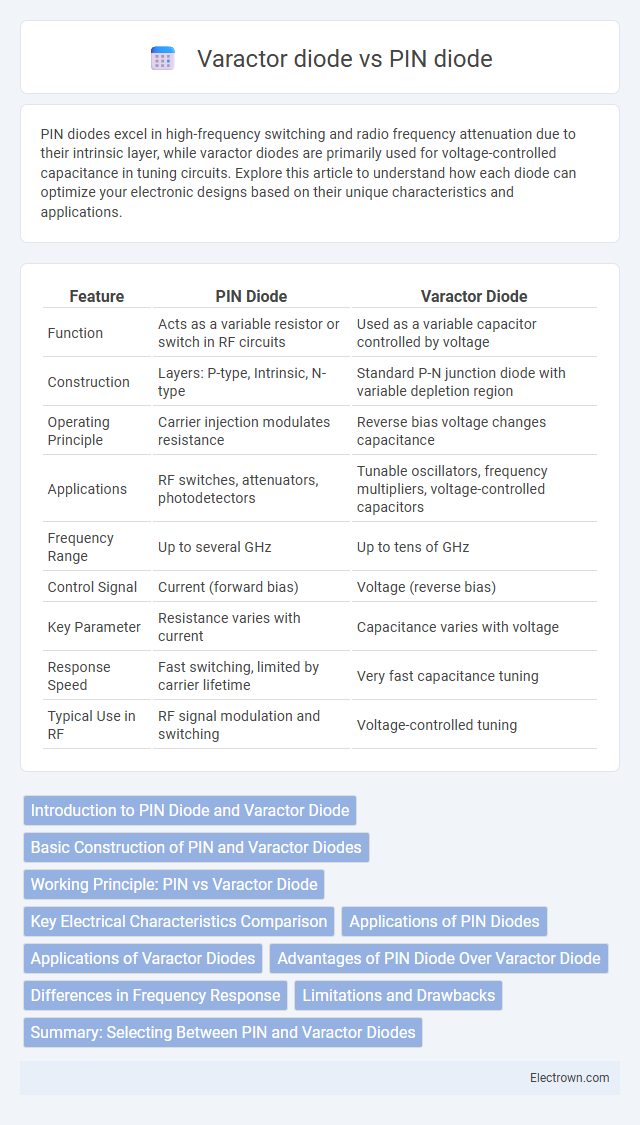PIN diodes excel in high-frequency switching and radio frequency attenuation due to their intrinsic layer, while varactor diodes are primarily used for voltage-controlled capacitance in tuning circuits. Explore this article to understand how each diode can optimize your electronic designs based on their unique characteristics and applications.
Table of Comparison
| Feature | PIN Diode | Varactor Diode |
|---|---|---|
| Function | Acts as a variable resistor or switch in RF circuits | Used as a variable capacitor controlled by voltage |
| Construction | Layers: P-type, Intrinsic, N-type | Standard P-N junction diode with variable depletion region |
| Operating Principle | Carrier injection modulates resistance | Reverse bias voltage changes capacitance |
| Applications | RF switches, attenuators, photodetectors | Tunable oscillators, frequency multipliers, voltage-controlled capacitors |
| Frequency Range | Up to several GHz | Up to tens of GHz |
| Control Signal | Current (forward bias) | Voltage (reverse bias) |
| Key Parameter | Resistance varies with current | Capacitance varies with voltage |
| Response Speed | Fast switching, limited by carrier lifetime | Very fast capacitance tuning |
| Typical Use in RF | RF signal modulation and switching | Voltage-controlled tuning |
Introduction to PIN Diode and Varactor Diode
A PIN diode features an intrinsic semiconductor layer sandwiched between p-type and n-type regions, making it ideal for RF switching and attenuation due to its variable resistance under forward bias. Varactor diodes function as voltage-controlled capacitors, exploiting the voltage-dependent capacitance of a reverse-biased p-n junction for tuning circuits such as voltage-controlled oscillators (VCOs). Your selection between a PIN diode and varactor diode depends on whether you require signal modulation through resistance changes or capacitance variation.
Basic Construction of PIN and Varactor Diodes
PIN diodes consist of an intrinsic (undoped) layer sandwiched between P-type and N-type semiconductor regions, enabling high-frequency switching and RF attenuation. Varactor diodes feature a P-N junction designed to function as a voltage-dependent capacitor, with charge depletion width varying based on applied reverse voltage. Understanding these basic constructions helps you select the right diode for tuning circuits or high-speed switching applications.
Working Principle: PIN vs Varactor Diode
PIN diodes consist of an intrinsic layer sandwiched between the p-type and n-type regions, enabling them to act as variable resistors when forward biased, primarily used for RF switching and attenuation. Varactor diodes operate by varying the width of their depletion region in response to reverse bias voltage changes, which alters their capacitance for voltage-controlled tuning applications. The key difference lies in the PIN diode controlling current flow through intrinsic layer conductivity, while the varactor diode adjusts junction capacitance for frequency modulation.
Key Electrical Characteristics Comparison
PIN diodes exhibit high reverse breakdown voltage and low capacitance in the off state, making them ideal for RF switches and attenuators. Varactor diodes are designed with a voltage-dependent capacitance that varies significantly with reverse bias, enabling tunable frequency applications in voltage-controlled oscillators and filters. The key electrical difference lies in the PIN diode's stable capacitance and high current handling versus the varactor diode's variable capacitance and lower power capacity.
Applications of PIN Diodes
PIN diodes are widely used in RF and microwave applications as switches and attenuators due to their ability to handle high-frequency signals and control current flow efficiently. Their intrinsic layer provides high resistivity under reverse bias, making them ideal for variable RF switch circuits and photodetectors in optical communication systems. You'll find PIN diodes essential in radar systems, RF modulating circuits, and power electronics where fast switching and signal modulation are critical.
Applications of Varactor Diodes
Varactor diodes are widely used in voltage-controlled oscillators (VCOs) for frequency tuning in RF and microwave communication systems, including phase-locked loops and frequency synthesizers. They play a crucial role in automatic frequency control circuits by varying capacitance in response to applied voltage, enabling precise tuning of filters, mixers, and modulators. Varactor diodes also find applications in voltage-controlled filters, tunable antennas, and parametric amplifiers due to their efficient voltage-dependent capacitance characteristics.
Advantages of PIN Diode Over Varactor Diode
PIN diodes offer superior power handling and linearity compared to varactor diodes, making them ideal for RF switch and attenuator applications. Their intrinsic layer provides fast switching speeds and low distortion, enhancing performance in high-frequency circuits. You benefit from increased reliability and efficiency when choosing PIN diodes over varactors in signal modulation and tuning operations.
Differences in Frequency Response
PIN diodes exhibit excellent performance at high frequencies, typically up to several gigahertz, due to their wide intrinsic layer that provides low capacitance and fast switching speeds. Varactor diodes, on the other hand, are primarily used for tuning and frequency modulation in microwave circuits, offering variable capacitance that changes with applied voltage, usually operating effectively up to tens of gigahertz. The key difference in frequency response lies in the PIN diode's ability to function as a fast RF switch or attenuator, whereas the varactor diode is optimized for continuous tuning and voltage-controlled capacitance in RF and microwave applications.
Limitations and Drawbacks
PIN diodes exhibit limitations such as slower switching speeds and higher insertion loss at high frequencies, making them less ideal for ultra-fast or low-loss applications. Varactor diodes face drawbacks including limited tuning range and sensitivity to temperature variations, which can impact frequency stability in voltage-controlled oscillators. Both devices require careful biasing to avoid non-linearities and signal distortion in RF circuits.
Summary: Selecting Between PIN and Varactor Diodes
PIN diodes are ideal for RF switching and attenuation due to their high linearity and low distortion, while varactor diodes excel in voltage-controlled tuning applications like voltage-controlled oscillators and frequency modulators. Your choice depends on whether you need a diode for signal modulation and tuning (varactor) or for fast, reliable switching and signal control (PIN). Understanding the application's frequency range and control requirements ensures optimal performance when selecting between PIN and varactor diodes.
PIN diode vs varactor diode Infographic

 electrown.com
electrown.com